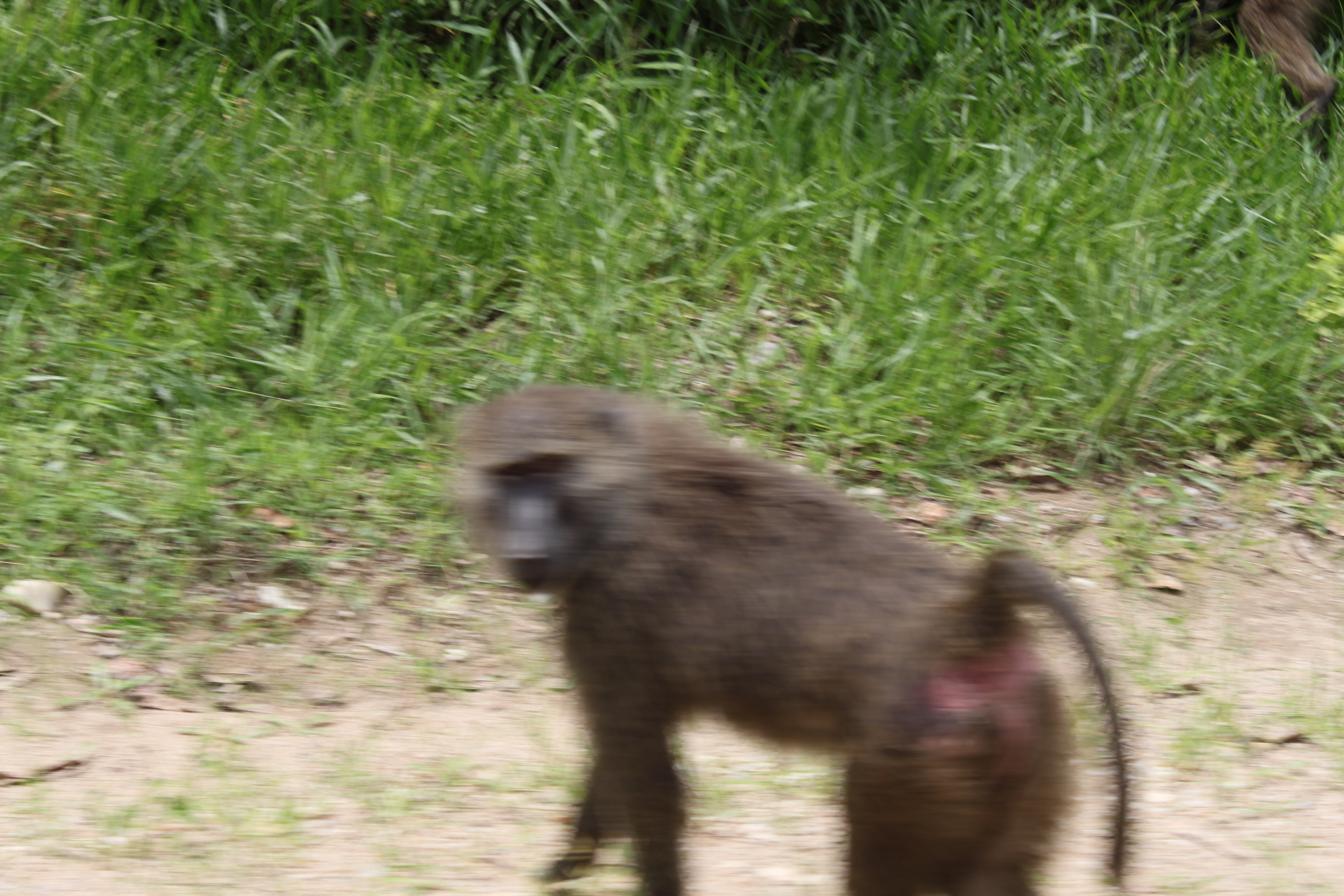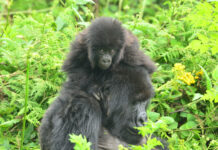Uganda’s number one tourist activity is mountain gorilla- located south of Bwindi Impenetrable Forest and Mgahinga Gorilla National Park. There is a remarkable diversity of life in the national parks of Mgahinga and Bwindi forest, where the regional landscape is varied and dramatic.
Bwindi Impenetrable Forest National Park is home to an impressive list of species with 200 different trees, 350 birds, 310 butterflies, 88 moths, 51 reptiles and 120 mammals including primates such as chimpanzees, black and white Colobus, blue monkeys and grey-checked mangabey, L’Hoest’s monkey and of course the mountain gorillas. The 14 habituated gorilla groups of Bwindi can be tracked from four trail heads. There are eight permits for each group a daily maximum of 80 permits. It takes 2 to 8 hours to experience mountain gorilla safaris depending on where the group is located.
Yet in spite of the long list of species here are source of wonders to zoologist and botanists the mountain gorilla is the star attraction. Today there are fewer than 800 examples of this endangered primate which lives only in the forest of the Virunga Volcanoes and Bwindi. Half of them live in Mgahinga on the Ugandan slopes of the Virunga and Bwindi. Uganda is a choice of those hoping to catch a glimpse of these magnificent great apes.
Tracking the mountain gorillas is one of the most remarkable as well as exclusive wildlife experiences anywhere. There are strict limits on access in order disturb as little as possible. Only eight people are allowed to track each of the habituated gorilla group each day, while viewing time is limited to one hour. Most visitors agree there is a special quality about these encounters.
The Impenetrable Forest is aptly named and visitors must be reasonably fit to take part in the adventure. The habitat of the gorilla is characterised by dense, tangled vegetation in a montane landscape of deep valleys and steep ridges. A recent addition to Bwindi’s list of activities longer and less predictable than normal gorilla tracking, it is Gorilla Habituation Experience, in which visitors can spend the day with teams habituating new gorilla groups in the presence of humans.
The gorillas are one of our closest relatives and there is often a profoundly moving sense of connection. Visually, the gorillas are spectacular creatures obviously intelligent and physically impressive, with a typical silver back weighing more than 200kg (450 Ib). A key aspect of gorilla tracking is that it helps to fund the continued survival of these rare animals in their natural habitats.
Bwindi is also a key destination for birdwatchers, one of the best in the country, with 350 bird types including many endemic Albertine Rift species. Community walks, outside the forest, give an insight into the lives of the Bakiga people and visitors can walk through nearby Buniga Forest with Batwa pygmy guide to learn more about the hunter-gatherer traditions of Uganda’s oldest extant tribe.
The Bwindi trail heads are eight to 10 hour’s drive from Kampala. The roads are tarmacked as far as Kabale and Rukungiri, with dirt roads beyond those towns, winding into the hills. It is best to take two days for the journey, stopping overnight in Lake Mburo. There are daily flights from Kampala to Kihihi, 40 km from Buhoma, with a journey time of just 90 minutes.
The Bwindi hills are inhabited by farming people the Bakiga, who have shaped the steep, terraced hills characteristic of the region. The margins of Bwindi and Mgahinga forests are inhabited by Batwa pygmies. Visitors can learn more about their traditional lifestyle by going on a forest walk.
Mgahinga Gorilla National Park
The northern slopes of the Virunga volcanoes provide a spectacular setting for this tiny park, covering just 38sq. km. Both mountain gorillas and golden monkeys can be viewed here, although the gorillas sometimes roam into the neighbouring Rwanda and DRC Congo. Visitors can climb the park’s three dormant volcanoes and at the summit of Mount Sabyinyo you can stand in Uganda, Rwanda and Democratic Republic of Congo all the same time. The guide Batwa Trail reveals aspects of forest life before descending into Garama Cave, once home to the Batwa King.
Panorama
Lake Bunyonyi: The second deepest lake in Africa offers a splendid panorama, dotted with islands and enclosed by steep, terraced hills. It’s island lodge and camps are the perfect place for visitors to recuperate after their gorilla tracking expeditions.
Lake Mutanda: The view across this little- known lake near Kisoro is truly stunning, even in a region known for its scenic highlights, as you gaze across the take, dotted with islands, towards the six Virunga volcanoes on the horizon. Local accommodation is ideally situated both for the views and for access to new gorilla tracking trail heads in southern Bwindi.
Lake Mburo National Park
Offering a welcome break on the long drive between Kampala and the gorilla parks of the south-west is Uganda’s smallest savannah park, covering just 370 sq. km. It features a mosaic of habitats including open water, wetland, grassland, woodland and forest patches. A perfect base for exploring the park in Mihingo Lodge, located on a Kopje of ancient granite. On game drives, a boat cruise and even on Horseback, visitors can view wildlife species not often seen in other Ugandan parks, including eland, impala, Topi and zebra.
Accommodation: Upmarket and mid-range option lodges are available at Lake Mburo and Bwindi plus Mgahinga trail heads. There is comfortable mid-range accommodation, too at Lake Bunyonyi and Lake Mutanda and in the regional towns of Kabale and Kisoro.
Queen Elizabeth National Park
A scenic destination rich in wildlife is probably the country’s most scenic and diverse park, with a splendid location on the floor of the Albertine Rift valley, 914 metres above sea level, at the foot of the Rwenzori Mountains. The park is home to some 95 mammal species and over 600 species supported by a variety of habitats that include lakes, rivers, open savannah acacia woodland, tropical forest and vast wetlands. It is an impressive range of fauna for a park covering less than 2,000 sq. km. Only the neighbouring and larger Virunga National Park in Congo has a large total in Africa.
Visitors are spoilt for choice in terms of activities, with the park offering boat trips on the 4th km Kazinga Channel, a tour of the spectacular volcanic craters, lion viewing on the Kasenyi Plains, Chimpanzee tracking in the Kyambura Gorge, walks in the Maramagambo Forest and game drives in the remote wilderness of Ishasha.
Channel cruises
A favourite visitor activity is the two- hour return launch trip from Mweya Peninsula along the Kazinga channel to Lake Edward. Crocodiles, hundreds of hippos and variety of water birds inhabit the shore, white herds of elephants, buffalo, leopard, water buck and Uganda Kob are regular visitor from the plains beyond.
Game viewing
The Kasenyi grasslands east of Mweya are an idea venue for lion encounters because of the prides in this area which prey on herds of Uganda Kob. Visitors can join in the park’s Predator Research Project as its members monitor radio-tagged prides. In the far south of the national park, the grassland of Ishasha are home to elephant, Topi, buffalo and the park’s most celebrated residents, the tree-climbing lions of Ishasha.
Hot Air Ballooning
While visitors search the Kasenyi grasslands at ground level for lions, hot air ballooning offers an exciting new perspective with a bird’s eye view of the morning’s activity. Later, well away from predators, the balloon travelers land for a bush breakfast.
Volcanic Craters
Flamingos are regular visitors to the craters at Kyambura and Katwe- part of a scenic cluster of extinct volcanic craters that can be viewed from the 24 crater Drive. Just outside the national park, at Katwe Salt Lake, visitors can see salt being produced in a process dating back for centuries.
Forest walks
Bird watchers can visit Maramagambo Forest and view forest species in addition to their water and grassland sightings; while nearby Kyambura Gorge is home to Chimpanzee and other primates.
Bird watching
Enthusiasts have a range of options, from easy water bird sightings from the relative comfort of a launch to careful searches for rare species in the Maramagambo Forest. Among the rare or remarkable birds are black-rumped buttonquail, board-billed roller, papyrus Gonolek, western-banded snake eagle, African fish eagle, white backed night heron, pel’s fishing owl, black bee eater, shoe bill, Rufus-bellied heron, great blue turaco, black and white casqued horn bill and African fin foot.
Accommodation
Hotels and lodges are available to meet all budgets. They include high-end lodges and tented camps as well as basic hostels, cottages and campsites. Mid-range and budget properties can be found outside the park boundary.
Getting there
By road there are two routes, both on good Kampala to Mweya in the heart of the par. The northern route goes via Fort Portal and Rwenzori 410km while the southern route passes Lake Mburo 420km. Ishasha, in the southern part of the park, is 63km from Bwindi Impenetrable National Park. There are daily flights from Kampala to airstrips near Mweya and Ishasha. Journey time is 90 minutes.






